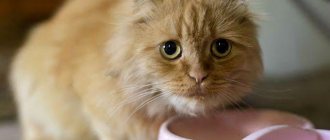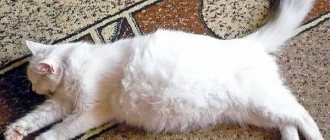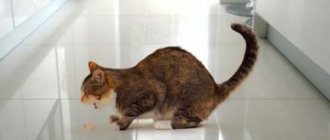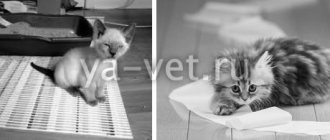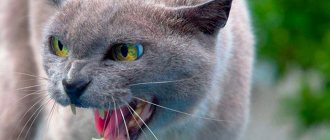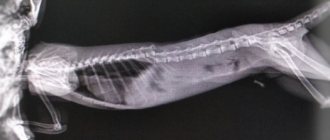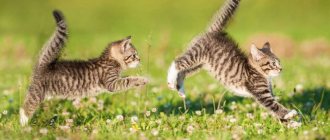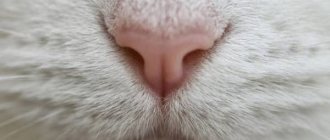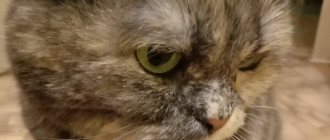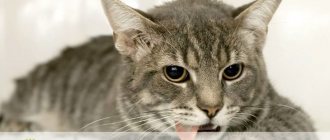The reasons why a kitten is constantly or periodically constipated can be varied. The most common include poor nutrition, progression of helminthiasis, and stress. If the problem is constantly bothering you and cannot be eliminated using usual means, it is better to visit a veterinarian who, based on the diagnostic results, can help cope with the disease. If constipation is left untreated and the disease progresses, the consequences can be unpredictable, including the death of the kitten.
Causes of constipation in a kitten
Constipation is a problem that some pets face. Delayed defecation occurs in babies, in particular in kittens. This phenomenon is unpleasant, and in some cases very dangerous. Therefore, measures must be taken immediately.
The answer to the question of what exactly needs to be done when a small kitten is constipated depends on the reasons that caused the malfunction in the body. There may be several of them.
Most common
Most often, defecation delay occurs due to digestive problems. Moreover, in kittens from birth to 3 months, various phenomena can affect intestinal function.
Kittens are born blind and deaf, and therefore in the first weeks of life they cannot do without their mother: she pushes them to the nipples and licks their tummy and places near the genitals. The last point is a very important point. Babies cannot go to the toilet on their own, and therefore the cat stimulates bowel and bladder emptying with a massage.
The second important point is that the microflora in the gastrointestinal tract of kittens appears when they feed first on colostrum and then on mother’s milk. For this reason, constipation in a newborn kitten can cause the baby to be switched to artificial nutrition due to the fact that the cat stops feeding the cubs (there are different reasons) or she does not have enough milk.
It’s a different matter when it comes to constipation in a kitten who is 1 month old or a little older - at this age the baby usually begins to supplement its feeding, which makes its intestines more vulnerable. The predominance of protein in the diet or lack of water, especially when dry food is introduced, low-quality industrial food - these and other phenomena cause the kitten to not be able to go to the toilet normally.
Closer to 2-3 months, a problem such as the presence of a foreign body or a hairball in the kitten’s intestines is added - they form a kind of plug, which leads to constipation. Foreign bodies are often small balls, buttons or pieces of cellophane. Kittens swallow them while playing or out of curiosity. Most often, hairballs appear in the stomach and intestines of babies of long-haired breeds.
Another common cause of constipation in kittens is a sedentary lifestyle. These animals need to constantly run, jump and play. Passivity leads to deterioration of intestinal motility and, as a consequence, constipation.
Kittens, like any living creature, can experience stress due to being separated from their mother, a change in environment, and the presence of unfamiliar people or animals nearby. And this is another reason for disruptions in the body.
A dirty litter tray also leads to constipation. Some kittens, already at an early age, refuse to go to the toilet if the owner did not have time (or did not want) to remove traces of the baby’s previous visit to the litter box. Therefore, pets retain feces - this is also typical for animals. This phenomenon, if repeated regularly, eventually turns into a problem.
Main reasons
In a newborn kitten of three weeks of age, constant problems with defecation often indicate congenital anomalies in the structure of the digestive organs. In a two-month-old baby, hard stool may indicate poor-quality nutrition or incorrectly selected foods for the first feeding. Other reasons why young kittens experience periodic or chronic constipation include:
- overeating or undereating;
- lack of fluid in the body;
- poor quality food;
- entry of a foreign object into the digestive organs;
- helminthic infestation;
- inactive lifestyle;
- kidney and liver diseases;
- neoplasms of a benign or malignant nature.
Possible serious pathologies
There are also more serious causes of constipation in kittens. Here are the most common ones:
- Worm infestation. The disease is serious and requires surgical intervention by a specialist, since parasites can seriously undermine the baby’s health. One of the signs by which you can determine that a kitten has worms is that its body becomes like a pear. It is not recommended to give parasite medications to your pet on your own. Here you need to consult a specialist: he will determine the type of parasites, select the appropriate drug and give recommendations on dosage.
- Neoplasms in the intestines. Tumors, polyps and other growths on the walls of the intestines lead to narrowing, and in the most serious cases, to complete blockage of the lumens. As a result, feces simply cannot move further and accumulate in the intestines.
- Injury to the intestinal walls. Often the cause is the ingestion of seeds with sharp edges.
You will not be able to cope with these problems on your own. Only a specialist can make a diagnosis and decide on therapy after conducting the necessary examinations.
What not to do
It is highly undesirable to deal with constipation in kittens using the following methods:
- Do not give your baby diluted cow's milk. Yes, such a remedy really “breaks through” constipation, but stagnation of feces in such cases is often replaced by violent and prolonged diarrhea. It is deadly for kittens, as it leads to rapid death from dehydration. In addition, this approach threatens with serious consequences for the animal’s liver.
- You should not give your kitten vegetable oil. This is a severe blow to the liver, and this remedy does not help very well against constipation.
- Never, under any circumstances, should castor oil be given to kittens. Perhaps the problem with constipation will be solved, but only at the cost of the death of the kitten.
- We strongly do not recommend using porridge to combat constipation in kittens! Their use will certainly lead to the exact opposite result, since the digestive system of cats is not physiologically adapted to such food.
Clinical symptoms
Before deciding what to do with a kitten in the first weeks of life, at 1 month, or with an older cat, you need to make sure that he really is constipated. After all, sometimes defecation once every 2-3 days can simply be a feature of the body.
Some tips on how to tell if your kitten is constipated:
- The baby doesn't go to the toilet for three days. Sometimes he has difficulty squeezing out some hard and dry feces in the form of small peas.
- The kitten sits in the tray for a long time in the appropriate position, as it cannot empty its intestines and meows loudly. The feces contain blood and mucus.
- The small pet becomes passive and apathetic and periodically makes alarming sounds. His appetite disappears or decreases. Vomiting (or frequent urge to do so) often occurs.
- The kitten's tummy becomes enlarged and tense. Touching it causes pain or discomfort in the baby.
If the pet is not helped in time, he begins to lose weight and experience fear of the litter box. The most serious consequences are intoxication of the body, intestinal ruptures and even death.
What to do if the cat does not go to the toilet
Many cat owners do not have a question about what to do when the cat does not walk for a long time. They decide to solve the problem on their own with the help of enemas within the walls of the house or laxatives. It’s good if the reason for the lack of stool is not a terrible disease and home methods will return the animal to full stool.
But the cause can also be a serious pathology, and then all independent attempts to return stool can only aggravate the situation. Don’t be lazy, entrust the health and life of your pet to professionals! Only competent professional treatment can completely and effectively rid your cat of problems.
First aid at home
Any malfunctions in the pet’s body should be a reason to go to the veterinary clinic. But in some cases, the owner is able to provide first aid to a constipated kitten at home. You just need to remember that the baby’s body is still quite fragile, and therefore you need to act very carefully.
Here are some options for what to do if your kitten is constipated before visiting the vet:
- A newborn baby who is left without a mother will most likely benefit from stimulation of the digestive process. To do this, you need to imitate the actions of a cat: moisten a cotton pad in warm water and give it a light massage of the tummy and areas near the genitals. If constipation is caused by changes in diet, this may be enough to make the baby poop.
- If the pet is older and is given dry food, you need to make sure that the kitten drinks more water. If the pet refuses to do this on its own, you need to periodically bring it to the bowl and tilt its muzzle towards it.
- Foods that cause constipation should be excluded from the diet of a kitten aged 2 months and older.
- Get your baby, who prefers to spend most of his time on the couch, to move. Balls or joint games will help with this.
Even an inexperienced owner can provide such assistance to a kitten. It is important that such actions will definitely not harm the small pet. If you suspect the presence of a foreign object, worms or intoxication in the intestines, it is better not to take risks, but try to immediately show the baby to the veterinarian.
Diagnostics
If the problem is long-term and treatment at home does not work, you need to contact a veterinarian. Usually, an examination and interview with the owner is enough to diagnose the animal.
If a foreign body is suspected, improper bone healing after a fracture, tumor, narrowing of the intestine, protrusion of the rectal wall, a manual examination of the rectum is performed.
In case of frequently recurring cases of constipation, laboratory tests are carried out to exclude diseases of internal organs and systems.
Prescribed:
- Clinical analysis of blood and urine.
- Study of thyroid function.
- X-ray of the abdominal cavity (to detect tumors, foreign bodies, fractures).
- If a tumor is suspected, ultrasound of the abdominal cavity and biopsy.
Professional veterinary care
The following activities require more experience with animals. And some of them are not at all advisable for an owner who has never encountered anything like this before. The best option is to talk to a veterinarian who will examine the kitten, give recommendations for further therapy and tell you how not to harm the baby.
Professional assistance includes the following:
- Abdominal massage. Somewhat reminiscent of the one they make for small children. These are circular stroking movements with your hand, which should start the work of the gastrointestinal tract. Massage will help your kitten if constipation is caused by poor diet, stress, or a small foreign body that can come out naturally.
- Duphalac, Lactusan and other similar lactulose-based drugs. They are prescribed for constipation in newborn children, and in the case of animals they will also be safe and effective. The drugs can be given to a pet who is several weeks old if he has been transferred to artificial feeding. The dose is selected taking into account the weight of the kitten.
- Vaseline oil. To some extent, a universal product: it can be dropped into the kitten’s mouth or added to food when taking emergency measures, as well as for prevention. Vaseline oil is often used in an enema. The product is not absorbed into the blood and intestines. When it enters the gastrointestinal tract, it envelops the intestinal walls with a film and covers feces, making them softer and faster out of the body. Usually the kitten is allowed to give Vaseline oil 2-3 times a day. It is better to discuss the permissible amount with your veterinarian.
- Soap in the form of a small candle. It is inserted into the kitten's anus if there are no signs that it is inflamed. A side effect when providing assistance in this way is sometimes an allergy to the composition of the soap, so it is recommended to choose only children's soap.
- Enema. To carry out the procedure, you can use a small bulb or a 10 mm syringe without a needle. Pure water or chamomile solution are suitable as a solution. The tip must be lubricated with greasy cream or Vaseline oil. The liquid is administered through the anus very carefully - the pet should be in a standing position over a tray or other container. It is undesirable to carry out the procedure yourself if the owner has never seen how it is done. The reason is that if you introduce a lot of liquid, the intestinal walls can burst, and this is fraught with more serious problems than constipation. An enema is also dangerous if there are neoplasms, foreign objects and wounds in the gastrointestinal tract. Typically, the cleansing procedure is carried out by a veterinarian after the cause of constipation has been determined.
The specialist determines the cause of constipation in a week-old, month-old or older kitten, and also decides what to do next after taking a full history. It includes:
- conversation with the owner;
- blood, urine and stool tests;
- X-ray with contrast agent:
- Ultrasound of the abdominal cavity.
In some cases, an MRI is performed - the procedure allows you to confirm or refute the suspicion of oncology.
Based on the results of the examinations, treatment is selected for the kitten. Sometimes it involves an enema, an IV with a maintenance drug, and surgical removal of a foreign object. After visiting the veterinarian and receiving recommendations, you must strictly follow all instructions to prevent complications of the disease. It is very important to complete treatment, including when it seems that your pet is no longer constipated.
Laxatives and manipulations
The principles of operation of the drugs with which a cat can empty its intestines are different. Based on the type of effect, medications can be divided into the following groups.
Osmotic
These drugs (give Guttalax, Duphalac) are not emergency medications and are used to normalize regular bowel movements in case of frequent constipation. The principle by which such drugs act is to draw fluid from the body’s cells. Filling with water, feces increase in volume and begin to put intense pressure on the intestinal walls. This process strengthens and makes the urge to empty the bowel more frequent. The active ingredient of the medicine is lactulose. The beneficial effect of this element is also manifested in supporting the proliferation of beneficial bacteria inside the intestines and in suppressing the activity of microorganisms that are dangerous to health. The effect of the drugs occurs one or two days after administration. Medicines are prescribed in case of dysbiosis, but such medicines are prohibited in case of renal failure. Uncontrolled use of osmotic drugs can lead to dehydration of the cat's body.
Volume increase
The principle of action of such volume-forming medications is simple: once inside the intestine, the substance begins to increase in volume due to the water entering the body. To achieve the intended effect, the cat must drink plenty of fluids while taking the medications. The result of the treatment does not manifest itself too quickly: the stool returns to normal within 12 hours to three days.
Lubrication
If a foreign object gets inside the cat’s body, such a mechanical barrier can block the path of normal exit of feces from the intestinal tract. Similar consequences can be caused by a large hairball formed from hair that the cat involuntarily swallows, tidying up its fur. In such a situation, products will help that lubricate the inner surface of the intestines and make it easier for solid objects to slide through the body until the end of their journey. Such medications are commonly called “malt pastes”. As a rule, veterinarians recommend Beaphar, Sanal or Gim-Cat malt paste.
Mitigation
Stool thinning medications allow you to provide your cat with quick help and quickly empty the intestinal tract. Such products are produced in the form of microenemas and act after a period of time from three to five hours. The drugs should not be used for pregnant or lactating females. The veterinarian recommends such dosage forms in cases where constipation threatens to intoxicate the body.
Stimulation
Stimulants act on the muscles of the intestinal tract, causing the muscles to contract frequently and intensely. Cycles of compression and contraction help move stool and remove feces from the animal's body. The duration of action of such laxatives is quite short: the animal is freed from stagnant masses within 6-8 hours. The negative effect of using drugs of this type is that the intestinal tract becomes accustomed to stimulation. If stimulant drugs are used frequently and uncontrollably, this will lead to the fact that the intestines will refuse to function without additional stimulation.
Home Recipes
Cat owners have long noted the effectiveness of certain foods in relieving cats of constipation. In cases where the malaise has not yet reached a difficult phase, you can solve the problem with home remedies. We offer several simple products to help improve your domestic cat's stool:
- Condensed milk. Canned milk from a can should be mixed with water, maintaining a ratio of one to three, and offered to the cat in small quantities several times a day. The time interval between two doses should be at least three hours. It should be remembered that condensed milk is contraindicated in diabetes.
- Vegetable oil. A few drops of oily liquid should be added to your cat's regular food. You can use sunflower, vegetable, olive oil, as well as coconut or flax oil. There is no need to abuse this product, since side effects in the form of negative effects on the animal’s liver are possible. This product is not suitable for kittens.
- Castor oil, Vaseline, how much to give? These pharmaceutical preparations are given to the animal directly into the oral cavity using a special syringe. The dosage is approximately 15 ml per 10 kg of weight. Taking such a medicine will lead to rapid release of the clogged intestinal tract. After the cat swallows the oil, the pet should not be fed until the drug takes effect. If there is no effect within five hours, the procedure can be repeated.
- Fresh milk has a pronounced laxative effect, so this food product should be given to your furry pet in small doses, divided into several servings per day. Excessive consumption of milk will weaken you greatly and lead to diarrhea.
- Squeezed juices and pureed vegetables. The following vegetables rich in fiber have laxative properties: pumpkin, beets, carrots. While playing with your pet, you can offer the cat a piece of one of these root vegetables.
- Healing herbs. A cat walking around a house in a village finds its own medicine without the help of its owner. Useful plants that have a laxative effect: lemon balm, catnip, rhubarb leaf, chamomile, buckthorn, cucumber leaves, aloe. In urban areas, these herbs are purchased at the pharmacy. It is better to consume beneficial flora in the form of an infusion. To prepare one glass of drink, you need to take a tablespoon of crushed natural product. When the drink is infused, the liquid must be cooled and strained. The recommended dosage is a teaspoon every 3-4 hours.
Cleansing enema and massage
Cleansing the intestinal tract through a cleansing enema is an effective way to combat intestinal blockage. This method is the fastest and most reliable, but some experience is required to carry out such a procedure. It is best to entrust cleaning your pet's intestines with an enema to a veterinarian or paramedic.
Chamomile decoction is best suited as a solution for administration using an enema. The temperature of the liquid should be slightly lower than the cat's body temperature in order to achieve the desired effect and not cause pain to the animal.
How to do and administer an enema correctly, the procedure for performing the manipulation:
- Draw into the enema a solution prepared in advance and cooled to the desired temperature.
- Apply lubricant (vaseline oil, linseed oil, castor oil) to the enema tip to facilitate insertion.
- Take the enema in your hands vertically and press slightly on the side until the first drops of liquid appear. Such actions ensure that no air bubble gets into the animal's intestinal tract.
- Using a circular motion, slowly insert the enema into the cat's anus.
- Increasing pressure on the enema, add liquid.
- After removing the device, place the cat's tail against the anus and hold the animal in this position in your arms for 10 minutes until the fecal stones come out.
The enema has a list of contraindications for which this procedure cannot be used:
- damage to the intestinal tract;
- bloody discharge from the anus;
- the pet suffers from heart or vascular disease;
- the cat’s body is infected with parasites;
- a female suffering from constipation is expecting a litter.
Is it possible to give a microlax enema to a kitten - it is not recommended, because... designed for people.
An alternative to an enema is to massage your furry friend's tummy. To carry out such a procedure, a high degree of trust is required in the relationship between the cat and the owner. Stroking should be done in a circle, moving clockwise, avoiding strong pressure.
Can complications occur?
One of the serious consequences of not treating constipation in a kitten is the transition of the disease to the chronic stage. This means that your pet will continue to have problems with bowel movements in the future: for example, from time to time he may have difficulty going to the toilet or his intestines will be partially emptied. This means that intoxication of the body will continue. Its manifestation is a noticeable decrease in activity, appetite and weight and frequent nausea.
Disease prevention
Preventive measures help eliminate problems with the gastrointestinal tract and constipation in kittens. It's not difficult to follow them. Here is what you need to do if your pet has had or periodically experiences constipation:
- Provide the kitten with quality food. You need to choose premium food and combine dry food with wet and canned food. Make sure your pet always has clean water in sufficient quantities. When eating natural foods, it is necessary to exclude from the diet foods that cause constipation.
- Make sure the tray is always clean.
- Organize outdoor games so that the kitten moves more.
- Brush your pet regularly. This will reduce the amount of hair your kitten ingests when licking itself.
- Get massages. To do this, you do not need to take any special actions. It is enough to stroke the kitten's tummy when it climbs onto your lap.
- In consultation with the veterinarian, give your pet Vaseline oil (it is important to follow the recommended dose).
Thus, constipation in a kitten is not as harmless a phenomenon as it might seem at first glance. Like any other malfunction in the body, it requires prompt action. And the best reward for the owner will be a healthy and cheerful pet.
Causes not related to digestion
Inflammation of the anal glands is another reason for delayed bowel movements. The glands contain an odorous, viscous substance that is released in large quantities every time you go to the toilet. This is how cats mark their territory. When the glands become inflamed, they become blocked and the cat experiences pain. She begins to hold back the urge to have a bowel movement, which can result in constipation.
Inflammation can be recognized by the following signs:
- itching;
- the animal licks the anal area;
- scratches his crotch on the floor.
A preventive measure is cleaning the anal glands using the squeezing method.
Treatment of constipation
Treatment for constipation in a cat depends on the causes of constipation. The main goal of therapy is to soften stool and remove it from the intestines.
If this is an isolated case, and it happened for the first time, then medications are not prescribed. If cases of defecation retention are frequent, the following methods are used:
- Water enema at the rate of 5-10 ml of water per 1 kg of animal weight. Enema with physiological saline solution with the same calculation of proportions. Enema with Vaseline oil for a cat. You can do an enema with Duphalac.
- Abdominal massage.
- Taking oral laxatives for cats.
- Medicines that promote the movement of feces through the colon (Bisacodyl suppositories or glycerin suppositories for children). Suppositories are used alone or together with oral laxatives.
- Increased physical activity.
- Changing the feeding diet: introducing coarse wheat bran and canned pumpkin into the feed.
- Switching to food for cats with digestive disorders. Many brands have such lines, for example, Hill's ID, Royal Canin Fiber Response, etc.
Mild degree
When constipation occurs for the first time, a diet with a high fiber content (psyllium bran, wheat, cereals) is prescribed. Bran is added to the food - 1-2 tablespoons per serving of food.
Before introducing fiber into the diet, give the cat plenty of water to enhance the effect and prevent the accumulation of fiber in the intestines. Typically, most cats benefit from dietary fiber to help cope with the problem.
If constipation occurs again in a cat, Vaseline oil (pure or mixed with milk) or a laxative based on cisapride is recommended: Peristil, Coordinax - 0.1-0.5 mg per 1 kg of body weight.
Average degree
In case of frequent relapses, it is recommended to treat constipation with lactulose-based laxatives: Duphalac, Portalac, Goodluck and increase the fiber content in the diet. The cat is given a laxative every 8 hours at a rate of 0.5 ml per 1 kg of its body weight. The substances in the composition increase the secretion of fluid in the intestines, which facilitates the passage of feces.
If the problem persists, the laxative Bisacodyl and prokinetic drugs Ranitidine or Nizatidine, which stimulate the motility of the digestive organs, are additionally prescribed. However, Bisacodyl should not be used daily. Long-term use of the drug is detrimental to the nerve cells of the intestinal lining.
In difficult cases, hard feces are removed using enemas. Sometimes, if the feces are very dry, the veterinarian will perform a manual bowel cleanse. The cat is given plenty of fluids and anesthetized using an endotracheal tube. Then a saline solution or warm water is introduced into the intestines and the hardened stool is manually kneaded.
If a cat has constipation accompanied by flatulence, then the gases are removed through a probe and then the cat is given Vaseline oil. Pain syndrome is eliminated by Spasmalgon or No-shpa.
If drug treatment does not help, surgery is performed to remove part of the colon.
Prevention
The best way to control the problem is prevention. Simple rules help reduce the risk of relapse:
- Regular combing of hair should be a mandatory procedure for caring for your cat.
- After treatment, nutritional adjustments are made with increased fluid intake. The pet needs to be fed foods with fiber and added vitamins and minerals.
- If possible, transfer from dry to wet food.
- Do not expose the animal to stress.
- A cat's life should be active. The cat is forced to move and play more.
- Give your pet a paste with cleansing phytomins.
- In the postoperative period, introduce probiotics into food.
